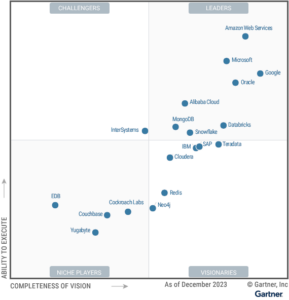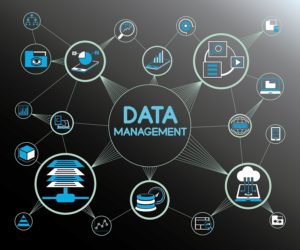The days of databases existing as islands unto themselves are over, according to Gartner, which reports the existence of a strong and growing signal for cloud databases to become part of “broader data ecosystems.” Last month, the analyst group rated the ecosystem participation of the top databases, and the results might surprise you.
In mid-December, Gartner released its 2023 Magic Quadrant for Cloud DBMS (CDBMS), which analyzed the market for transactional and analytical databases running in public and private clouds. Nineteen cloud DBMS vendors made the final cut for the quadrant, which was dominated by the likes of AWS, Microsoft Azure, Google Cloud, and Oracle.
A major trend identified by the Gartner analysts is the co-mingling of standard database features and capabilities with the features and capabilities offered in the broader market for data management tools, which have traditionally resided outside of the DBMS proper.
In the past, database customers usually turned to independent software vendors (ISVs) for data management functions like data lineage tracking, data governance, data integration/ETL, data quality, and data security. Many of these functions have been conglomerated into so-called data fabrics, which ensure a measure of repeatability and consistency in various data management processes.
But according to Gartner’s analysts, database vendors are now reaching out and working more closely with the data management ISVs, and vice versa. As the most important layer in the data stack, it’s great that databases are playing nicely (or playing nicer, anyway) with the array of other important data management products that companies must rely upon to get value from data while minimizing cost and risk.
While not all DBMS providers are working with ISVs in the same degree or manner, there’s a clear trend toward DBMSs playing in the data ecosystem, according to Gartner.
“Cloud DBMS systems are already beginning to be aware of, and collaborate with, the other data management components around them,” Gartner writes. “This does not mean that the cloud DBMS systems will subsume the functions of those other systems; rather, they will be aware of them and add more value by interoperating with them.”
There has been “a major improvement in capabilities” around Cloud DBMS participation in broader data ecosystem and “a conscious aim to interoperate with them,” Gartner says. “If anything, progress toward this is faster than expected, with many significant vendor announcements since last year’s cloud DBMS Magic Quadrant.”
The trend toward playing in data ecosystems is a broader one that is not isolated to cloud DBMSs or DBMSs in general (you’ll remember back in 2019, when Gartner predicted that the cloud would usurp the majority of the DBMS market, which is the process of happening–55% of DBMS spending was on the cloud in 2022, Gartner says, and the cloud accounted for 98% of all growth in the entire DBMS market).
Gartner says that by 2025, 90% of new data and analytics deployments “will be through an established data ecosystem, causing consolidation across the data and analytics market.” What’s more, it says that by the end of next year, 55% of IT buyers will have adopted a data ecosystem. “That will consolidate the vendor landscape by 40%, thereby reducing cost while reducing choice,” the analyst group says.
Data Ecosystem Ratings
Gartner gave higher marks to some cloud DBMSs for their participation in data ecosystems. While it didn’t specifically mention data ecosystem participation or interoperability in all 19 of the vendor profiles in its Magic Quadrant, it did for 10 of them. Here’s a summary of what it said for those 10:
Recent partnerships Alibaba Cloud made with ISVs like MongoDB, ClickHouse and PingCAP has demonstrated improvement in its cloud ecosystem, Gartner says. “This provides more choice in third-party D&A [data and analytics] solutions with less integration effort on Alibaba Cloud,” Gartner says in its Magic Quadrant, which featured Alibaba Cloud in the Leaders quadrant.
Gartner also discussed AWS’s movements toward a data ecosystem. It states that the cloud giant has the resources “to move toward a more integrated set of solutions, building on the work started with Amazon DataZone,” the data management service that went GA last October and which is composed of a data portal, a data catalog, data projects and environments, and a governance and access control layer. However, Gartner also cautioned about going with an all-AWS eco-system, which raises lock-in concerns.
Cloudera, which Gartner put in its Visionaries quadrant, received high marks for its data ecosystem work. “Cloudera continues to invest in its open-source leadership to drive innovation through the community with open standards in its data ecosystem delivering portable data and AI services across all cloud data architectures,” Gartner says. “With a centralized control plane across all clouds and on-premises, it delivers integrated security, metadata and governance with applied observability and an open data ecosystem.”
Gartner noted that ecosystems available through cloud providers are more “tightly integrated” and are “easier to use” than Cloudera’s. However, Cloudera’s dedication to multi-cloud and hybrid deployments, and ease of portability on workloads, “is an effective counterbalance to this competitive pressure that will require sustained effort to remain effective,” Gartner says.
Couchbase, which develops a NoSQL database used primarily for transactional and operational use cases, was lauded by Gartner for its capabilities in mobile and edge and for the ease of use of Capella, its managed database service. However, Couchbase’s ecosystem support is lacking, according to Gartner, which placed Couchbase in the Niche Players quadrant.
“Couchbase does not have a full-fledged capability to access data nor provide data to engines outside of the Couchbase world, although they are on its roadmap,” the analyst group says. “The ability to broadly interact with multiple engines across an ecosystem is driving increasing flexibility and efficiency in multiple use cases, most prominently analytics and AI. Other nonrelational products also have this limitation.”
Databricks, which Gartner placed in the Leaders quadrant, received high marks for Unity Catalog, the company’s metadata catalog and governance hub for data that exists in Databricks as well as outside repositories. Gartner also lauded the data ecosystem bonafides of Delta Live Tables for its capability to simplify ETL pipeline development for streaming, batch, and AI workloads.
Gartner also had good things to say about the data ecosystem participation of Google Cloud, which also launched in the Leader quadrant. In particular, Gartner applauded Dataplex, its metadata/governance layer that enables a more integrated data ecosystem.
Microsoft, which landed in Gartner’s Leaders quadrant, also got high marks for its willingness to make its database more open and to work with other Microsoft products, including Microsoft 365, Power BI, and Purview but also with external solutions from ISVs.
“This enables a more consistent experience for its clients,” Gartner says. “At the same time, the ‘one lake’ direction in Microsoft Fabric brings more openness to data in non-Microsoft systems, which the potential to reduce its clients’ vendor lock-in concerns.” However, some Microsoft customers have expressed concern about the complexity of Microsoft DBMSs ecosystem capabilities , which hurt performance, security, and cost control, Gartner says.
SAP, a Visionary in Gartner’s Magic Quadrant, was lauded for its capability to run operational and analytical workloads in the same HANA database. Gartner also liked SAP Datasphere’s capability to unify SAP and non-SAP data in an ecosystem play.
“SAP is now much more open in its ability to import and export data between SAP and non-SAP environments via file exchange, replication and federation,” Gartner says. However, few non-SAP customers are going to use SAP to manage data, the analyst group says. And Datasphere is likely to be used by customers with “a significant SAP technology presence.”
Snowflake, which develops an analytical data warehouse and is in the Leaders quadrant, also got a nod from Gartner for its “robust” ecosystem capabilities. “Snowflake promotes the philosophy of an easy-to-use integrated solution complemented by a robust data-sharing and data marketplace story,” Gartner says.
Teradata is another data warehouse provider playing in the data ecosystem. Gartner, which put Teradata in the Visionary quadrant, likes Teradata’s QueryGrid functionality, which “implements access to data outside of Teradata efficiently by intelligently pushing down processing where appropriate, offloading cycles from the Teradata machine, and reducing the amount of data that has to be returned to Teradata,” Gartner says.
Cloud DBMSs obviously have capabilities beyond their integration with third-party data management tools and broader data ecosystems. But as Gartner has shown, the ecosystem grade of a database is becoming a more important consideration for database buyers.
Databricks is offering a download for the full 2023 Gartner Magic Quadrant for CDBMS. You can access it here.
Related Items:
Cloud Databases Are Maturing Rapidly, Gartner Says
Who’s Winning the Cloud Database War
Cloud Now Default Platform for Databases, Gartner Says
The post How Broad Is Your Database’s Data Ecosystem? Gartner Takes a Look appeared first on Datanami.





0 Commentaires